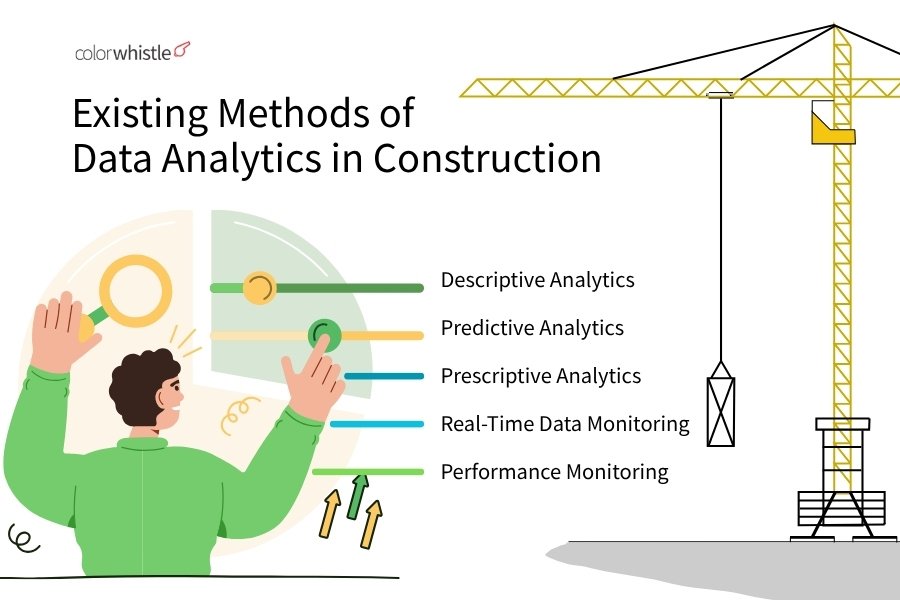The construction sector is experiencing a major shift due to the influence of data analytics, which boosts subcontractor efficiency and enhances project performance. As projects grow more intricate, the capacity to utilize data for strategic decision-making becomes essential. It’s not just on-site efficiency,even areas like planning, property management, and real estate website design can benefit from data-driven insights. This blog delves into the important function of data analytics in the construction industry, offering insights into its uses, advantages, and practical examples.
What is Data Analytics?
Data analytics is the process of examining raw data to find useful information that helps organizations make better decisions. It involves collecting, cleaning, and analyzing data to uncover patterns and trends. Data analytics allows businesses to gain insights into their operations, improve efficiency, and understand customer behavior.
Benefits of Utilizing Data Analytics to Your Business
- Data analytics offers objective insights, reducing reliance on gut feelings and minimizing risks.
- Identifies operational bottlenecks, optimizing processes, resource allocation, and cost savings.
- Enhances understanding of market trends and consumer behavior for competitive advantage.
- Reveals cost-saving opportunities through improved operations and resource management.
- Identifies risks early and enables strategic mitigation.
- Guides product development and enhancements based on customer preferences.
- Forecasts market changes and consumer behavior for proactive decision-making.
- Automates routine tasks, boosting productivity and freeing employees for high-value work.
- Fuels innovation by highlighting emerging trends and consumer demands.
Also Read
Role of Data Analytics in the Construction Industry
- Data analytics enhances construction workflows, resulting in better project results and fewer delays.
- Predictive analytics plays a crucial role in identifying potential risks by examining historical data, which empowers teams to take preventive actions.
- Organizations can foresee delays and equipment malfunctions by evaluating previous project data and facilitating improved scheduling and resource management.
- Analyzing material consumption and workforce efficiency contributes to cost reduction and minimizes downtime on construction sites.
- Centralized data systems improve communication and collaboration among project participants, promoting effective teamwork.
- Access to real-time data enables construction managers to make swift, informed decisions.
- Incorporating data analytics fosters innovation, allowing companies to navigate the challenges of contemporary construction projects.
- Utilizing data analytics helps organizations maintain a competitive edge in a fast-changing market.
Existing Methods of Data Analytics in Construction

1. Descriptive Analytics
Descriptive analytics focuses on historical data to gain insights into past project activities. It aids in recognizing trends, patterns, and potential areas for enhancement. For instance, a construction firm might review material consumption across multiple projects to pinpoint recurring overruns or inefficiencies.
This approach is frequently utilized for reporting, offering valuable insights into historical project performance metrics, including costs, timelines, and resource distribution.
2. Predictive Analytics
Predictive analytics for the construction industry employs statistical models and machine learning techniques to project future outcomes based on historical data. This approach is especially beneficial for forecasting project delays caused by factors such as adverse weather or supply chain issues.
Organizations leverage predictive analytics to enhance scheduling and resource management.
For example, if a predictive model suggests that rain may delay a concrete pour, project managers can modify their plans accordingly.
3. Prescriptive Analytics
Prescriptive analytics advances beyond mere prediction by also providing recommendations based on various scenarios. This method assists construction managers in making well-informed decisions regarding resource distribution and risk management.
For instance, prescriptive analytics may recommend implementing additional safety protocols if data reveals a heightened risk of accidents in a particular area of the construction site.
4. Real-Time Data Monitoring
The use of IoT devices and sensors facilitates real-time monitoring of construction sites. These devices gather data on equipment utilization, worker safety, and material conditions, delivering immediate insights that can guide decision-making.
Real-time data enables project managers to swiftly address issues as they occur, such as equipment failures or safety risks.
Also Read
5. Performance Monitoring
Data analytics tools monitor key performance indicators (KPIs), including labor productivity and equipment utilization. By consistently assessing these metrics, organizations can detect performance challenges at an early stage and initiate corrective measures.
For example, if a project manager observes that labor productivity remains consistently under target during specific construction stages, they can explore the underlying reasons and make necessary adjustments to enhance efficiency.
Construction Companies That Have Utilized Data Analytics in Their Projects
Crossrail
HS2 (High Speed 2)
Crossrail represents one of Europe’s most significant infrastructure initiatives, focused on enhancing transportation within London.
Data Analytics Utilization, The project leveraged predictive analytics to identify potential risks and delays. By examining historical data related to weather patterns, workforce availability, and material procurement, the team was able to make proactive adjustments to schedules and resource distribution.
HS2 is a prominent railway initiative in the UK to enhance connectivity among major urban centers.
Data Analytics Utilization, HS2 integrated IoT sensors to gather real-time information on equipment utilization and worker safety. This data was analyzed to streamline operations and ensure adherence to safety regulations.
The project also utilized centralized data platforms to foster better stakeholder collaboration, thereby improving decision-making processes.
How Data Analytics Can Be Improved Beyond 2025?
The landscape of data analytics in the construction sector is poised for substantial transformation, fueled by technological advancements and innovative methodologies. Improved predictive analytics will enable construction companies to utilize historical data more effectively, allowing them to foresee project delays, budget overruns, and equipment malfunctions with heightened precision. This evolution will equip construction managers to make timely, informed decisions, optimize resource distribution, and enhance overall project performance.
Furthermore, the incorporation of artificial intelligence and machine learning into construction data analytics will broaden access to insights, empowering non-experts to interpret complex data without needing extensive technical knowledge.
By prioritizing real-time data processing and sophisticated visualization tools, the construction industry can foster better collaboration among stakeholders and streamline operations, leading to smarter, more efficient building practices that address the challenges of a competitive marketplace.
Building a Data-Driven Tomorrow in Construction
The integration of data analytics into the construction industry represents a paradigm shift that enhances productivity significantly. Incorporating insights gained from data analysis, can improve the performance metrics, optimize resource allocation, enhance safety measures, and foster better collaboration with other stakeholders.
Adopting robust data analytics practices is not just beneficial, but essential for success in today’s dynamic construction environment. The future belongs to those who harness the power of their data effectively, transforming challenges into opportunities for growth and excellence in project delivery.
Stroll through our ColorWhistle pages to discover our tailored real estate website design services. Ping us or call us at +1 (919) 234-5140, and we’ll be on it like paint on a canvas! Our services are as unique as your business, let’s make magic happen together!
What’s Next?
Now that you’ve had the chance to explore our blog, it’s time to take the next step and see what opportunities await!





